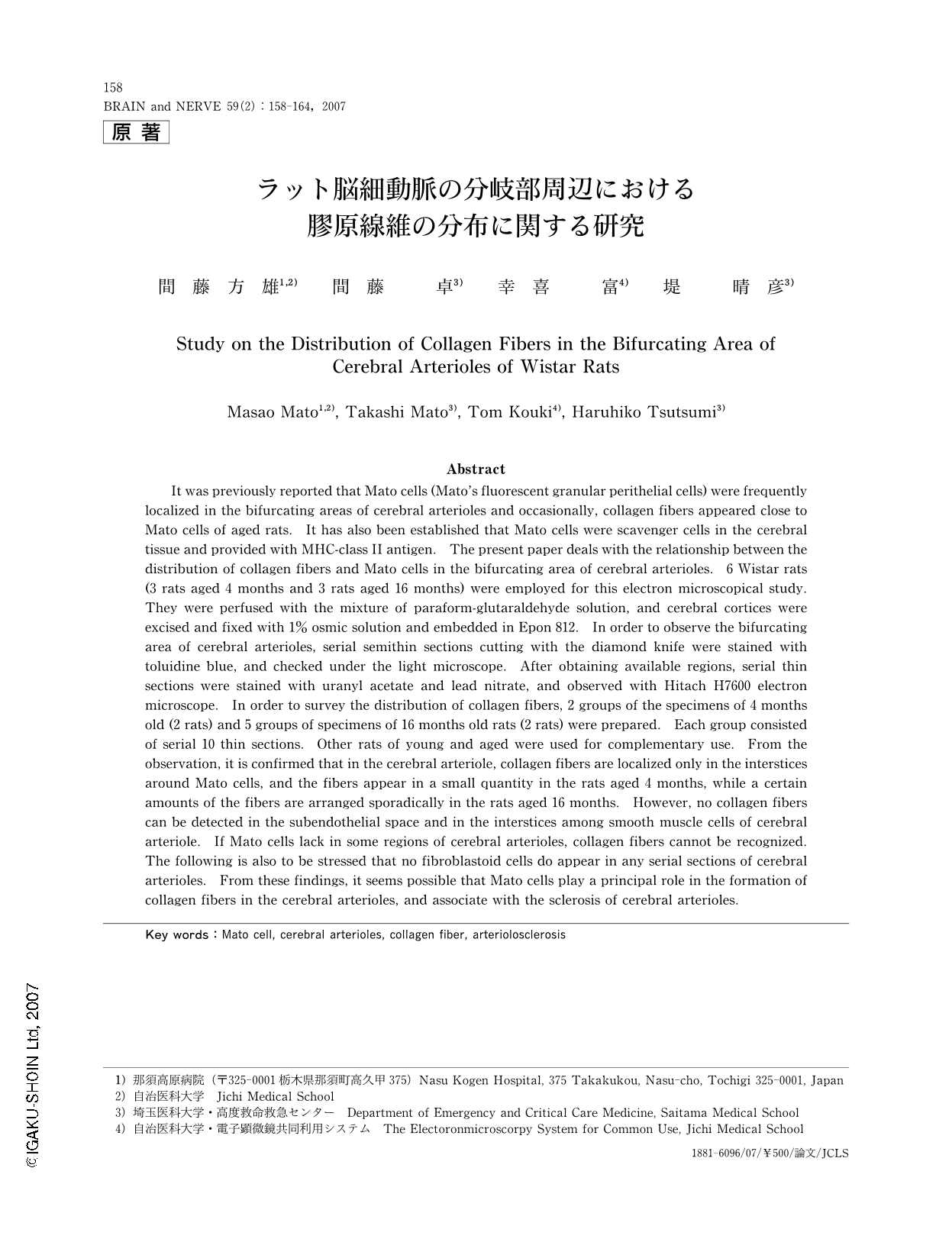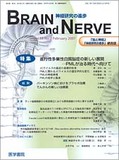Japanese
English
- 有料閲覧
- Abstract 文献概要
- 1ページ目 Look Inside
- 参考文献 Reference
はじめに
筆者らはかつて脳細動脈を観察中,血管周辺に蛍光性顆粒を持った細胞(後の間藤細胞)に気づくと共に,老年ラットにおいては膠原線維が同細胞と血管壁および神経組織の間に見出されることを経験し,同細胞と膠原線維の分布との関連に関心を持った1,2)。
その後の研究により脳細動脈にはその周囲に独特なマクロファージ系のエピトープを備えた蛍光性顆粒細胞〔Mato's FGP cell (fluorescent granular perithelial cell):間藤細胞〕が蜘蛛の巣状に巻きつき,スカベンジャー機能および免疫機能を果たすことが内外の研究者により研究され明らかにされてきた1-8)。同細胞は脳軟膜に由来し,細動脈の分岐部に高頻度に見出され,若い動物では,脳室内,静脈内に投与された物質を特異的に摂取するが,老化動物では大型化,空胞化し取り込み能が低下し,血管腔を狭小化することも知られている2,5)。しかし現在まで,脳細動脈周囲の膠原線維と間藤細胞との関係を明らかにした報告はない。
本研究では,出生後4カ月のラットと16カ月のラットを用い,分岐部周辺の細動脈血管壁における膠原線維の分布について経時的,形態学的に検討した結果を簡潔に報告したい。
It was previously reported that Mato cells (Mato's fluorescent granular perithelial cells)were frequently localized in the bifurcating areas of cerebral arterioles and occasionally, collagen fibers appeared close to Mato cells of aged rats. It has also been established that Mato cells were scavenger cells in the cerebral tissue and provided with MHC-class II antigen. The present paper deals with the relationship between the distribution of collagen fibers and Mato cells in the bifurcating area of cerebral arterioles. 6 Wistar rats (3 rats aged 4 months and 3 rats aged 16 months) were employed for this electron microscopical study. They were perfused with the mixture of paraform-glutaraldehyde solution, and cerebral cortices were excised and fixed with 1% osmic solution and embedded in Epon 812. In order to observe the bifurcating area of cerebral arterioles, serial semithin sections cutting with the diamond knife were stained with toluidine blue, and checked under the light microscope. After obtaining available regions, serial thin sections were stained with uranyl acetate and lead nitrate, and observed with Hitach H7600 electron microscope. In order to survey the distribution of collagen fibers, 2 groups of the specimens of 4 months old (2 rats) and 5 groups of specimens of 16 months old rats (2 rats)were prepared. Each group consisted of serial 10 thin sections. Other rats of young and aged were used for complementary use. From the observation, it is confirmed that in the cerebral arteriole, collagen fibers are localized only in the interstices around Mato cells, and the fibers appear in a small quantity in the rats aged 4 months, while a certain amounts of the fibers are arranged sporadically in the rats aged 16 months. However, no collagen fibers can be detected in the subendothelial space and in the interstices among smooth muscle cells of cerebral arteriole. If Mato cells lack in some regions of cerebral arterioles, collagen fibers cannot be recognized. The following is also to be stressed that no fibroblastoid cells do appear in any serial sections of cerebral arterioles. From these findings, it seems possible that Mato cells play a principal role in the formation of collagen fibers in the cerebral arterioles, and associate with the sclerosis of cerebral arterioles.

Copyright © 2007, Igaku-Shoin Ltd. All rights reserved.


